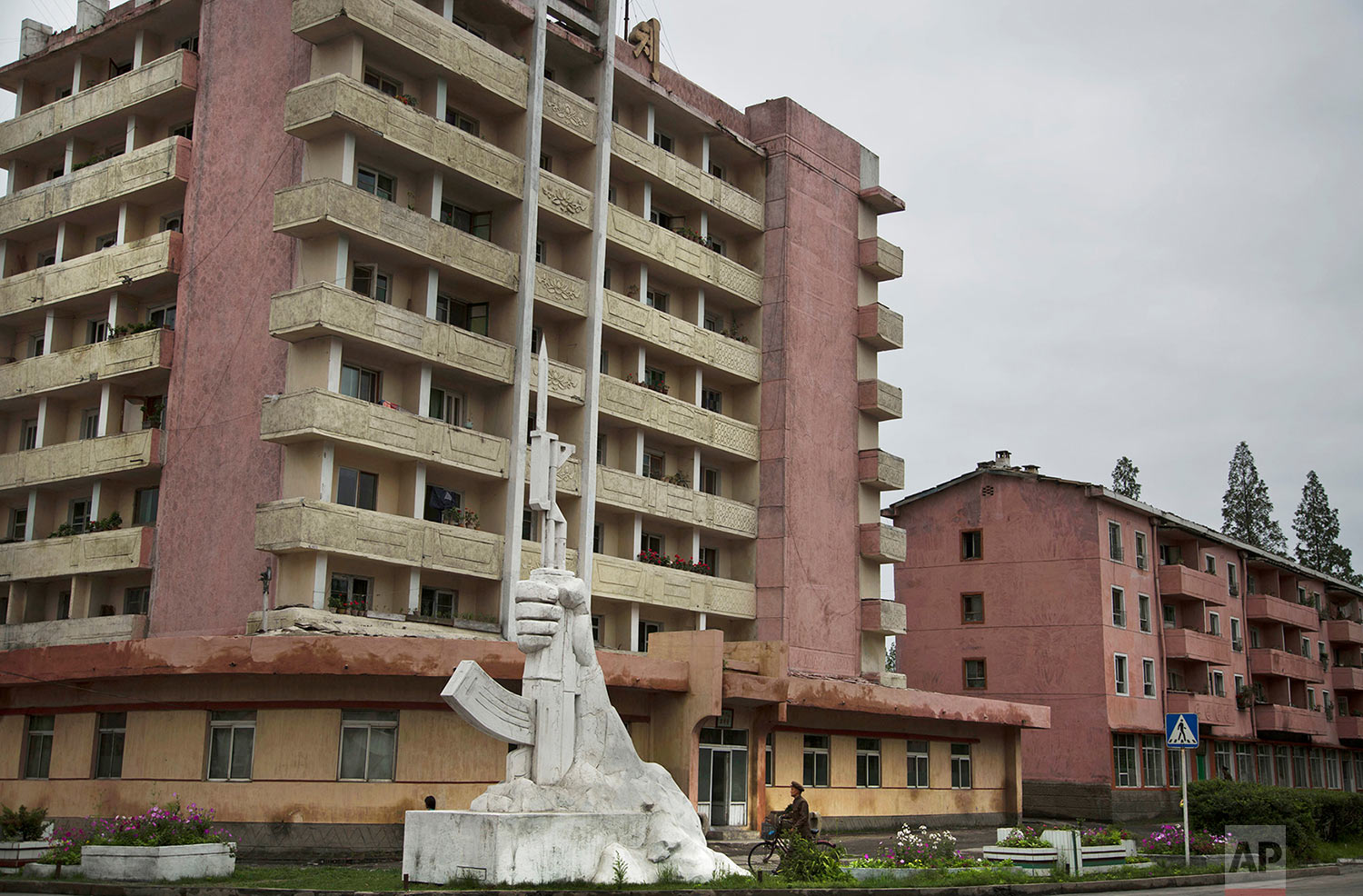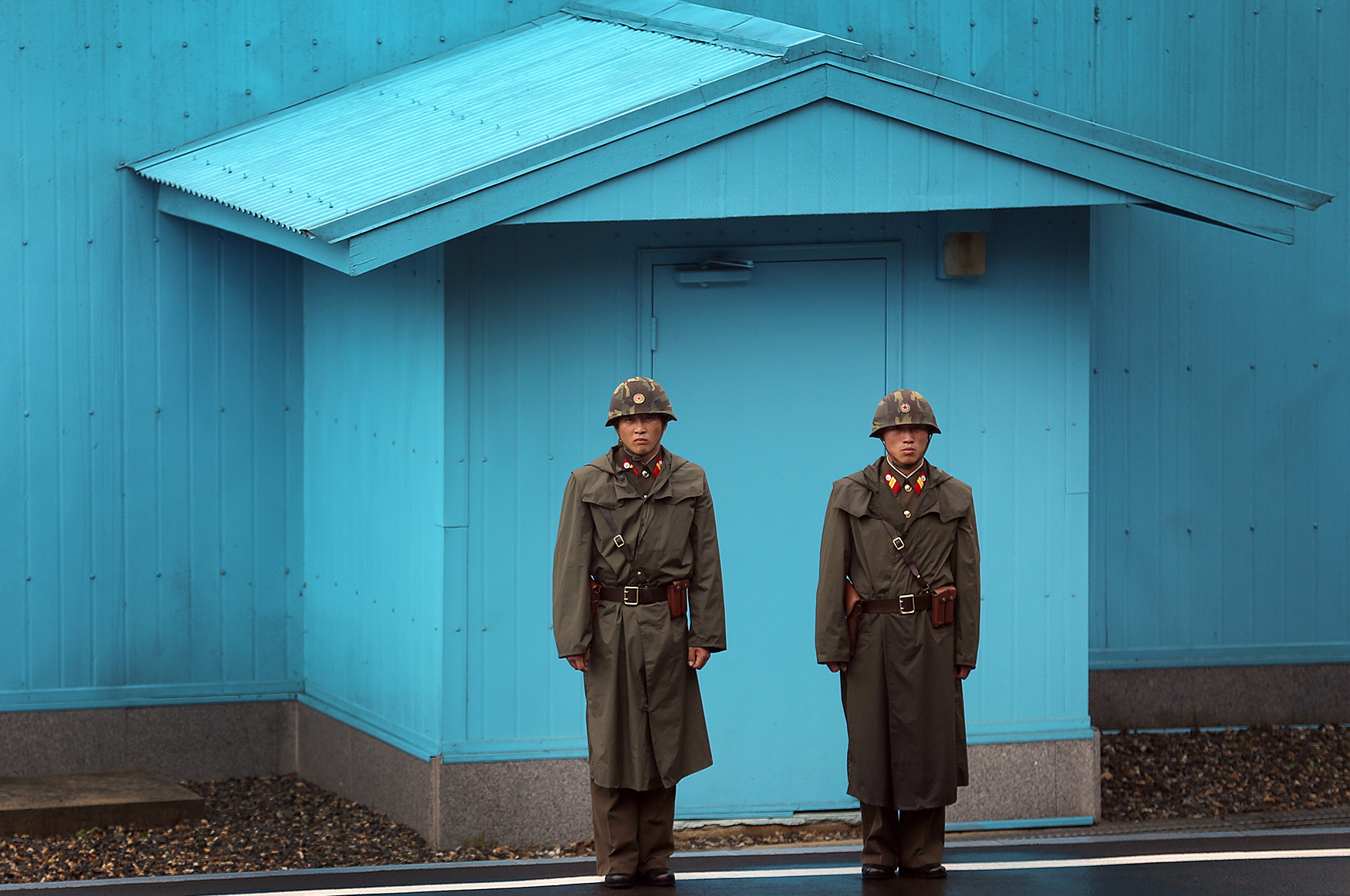North Korea: Monuments

In the totalitarian world of Kim Jong Un’s North Korea, everything begins from the center of Kim Il Sung Square, Pyongyang’s physical and spiritual center. And every neighborhood, it seems, has some sort of a statue or monument in honor of the Kim’s and the nation their created.

Women prepare to bow before the statue of late North Korean leader Kim Il Sung, erected on Mansu Hill in Pyongyang, North Korea, on Aug. 5, 2007. (AP Photo/Elizabeth Dalziel)

A statue of Korean soldiers stands in central Pyongyang, North Korea, on Feb. 26, 2008. (AP Photo/David Guttenfelder)

North Koreans wave artificial flowers at an unveiling ceremony for statues of the late leaders Kim Il Sung and Kim Jong Il in Pyongyang, North Korea, on April 13, 2012. (AP Photo/David Guttenfelder)

The 105-story pyramid-shaped Ryugyong Hotel towers over residential apartments, forming the skyline of Pyongyang, North Korea, on May 7, 2016. (AP Photo/Wong Maye-E)

The bronze statues of late North Korean leaders Kim Il Sung and Kim Jong Il tower over people in Pyongyang as they watch fireworks explode on July 27, 2015, during a celebration of the 62nd anniversary of the armistice that halted the Korean War. (AP Photo/Wong Maye-E)

A statue known as the Monument to the Three Charters for National Reunification, which symbolizes the hope for eventual reunification of the two Koreas, arches over a highway at the edge of Pyongyang, North Korea, on April 18, 2011. (AP Photo/David Guttenfelder)

A group of women bow to bronze statues of the late leaders Kim Il Sung and Kim Jong Il at Munsu Hill in Pyongyang, North Korea, on July 27, 2015, amid celebrations to mark the 62nd anniversary of the armistice that halted the Korean War. (AP Photo/Wong Maye-E)

School children tour the park surrounding Kumsusan Palace of the Sun, the mausoleum where the bodies of late leaders Kim Il Sung and Kim Jong Il lie embalmed, in Pyongyang, North Korea, on Thursday, July 25, 2013. (AP Photo/Wong Maye-E)

A monument of a fist holding a bayonetted Kalashnikov rifle stands on a roadside in North Korea's South Hamgyong province on June 21, 2014. (AP Photo/David Guttenfelder)

A young North Korean man stands reading next to statues at the Ju Che Tower in Pyongyang on July 21, 2013. (AP Photo/Wong Maye-E)

A man is silhouetted against a statue of the late North Korean leader Kim Il Sung at the newly opened Fatherland Liberation War Museum in Pyongyang, North Korea, during a celebration of the 60th anniversary of the Korean War armistice on June 27, 2013. (AP Photo/Wong Maye-E)

North Koreans bow in front of bronze statues of the late leaders Kim Il Sung, left, and Kim Jong Il at Munsu Hill in Pyongyang on July 27, 2015. The statues were created by artists from Mansudae Art Studio. Since its opening by Kim Il Sung in 1959, the studio has produced an estimated 38,000 statues and 170,000 other monuments for domestic use. (AP Photo/Wong Maye-E)

A woman walks near the 105-story Ryugyong Hotel in Pyongyang, North Korea, on Oct. 22, 2014. Construction on the massive hotel began in 1987, but the country's economic difficulties forced the project into repeated delays. Three decades later, the building has become a major Pyongyang landmark but has never been used as a hotel. (AP Photo/Wong Maye-E)
North Korea Galleries
The headlines are all about nuclear weapons and ballistic missile launches. But on the ground in North Korea, scenes of daily life attest to both the poignancy and resilience of a people struggling to succeed.
Along with its famous mass games, North Korea has taken the tradition of the military parade to a level all of its own. Its parades are used to show off the best and newest weapons in its arsenal and the almost-unhuman precision of its goose-stepping troops.
As the heroes of socialist propaganda, they are depicted as a self-sacrificing, proud proletariat upon whom the weight of the nation is said to depend. But the life of the worker in North Korea has never been easy.
In the totalitarian world of Kim Jong Un’s North Korea, everything begins from the center of Kim Il Sung Square, Pyongyang’s physical and spiritual center. And every neighborhood, it seems, has some sort of a statue or monument in honor of the Kim’s and the nation their created.
Grassroots barter and trade that began as a necessity in the famine years of the 1990s has grown into a quasi-legal market system that is now one of the most important drivers of North Korea’s domestic economy. For those who know how to navigate it, called the “money masters”, there are riches to be had.
For more than 60 years, the artificial dividing line between the two Koreas has separated families and stood as a testament to hostilities that have seemed to have no end. The Demilitarized Zone, despite its name, remains the world’s most heavily fortified border.
Visual artist and Journalist






Kim Jong Un is the third generation of North Korea’s ruling Kim family, the first and now only hereditary socialist dynasty. But while still in his early thirties, he appears to be as deft with wielding power as his grandfather, “eternal president” Kim Il Sung, and father, “Dear Leader” Kim Jong Il.